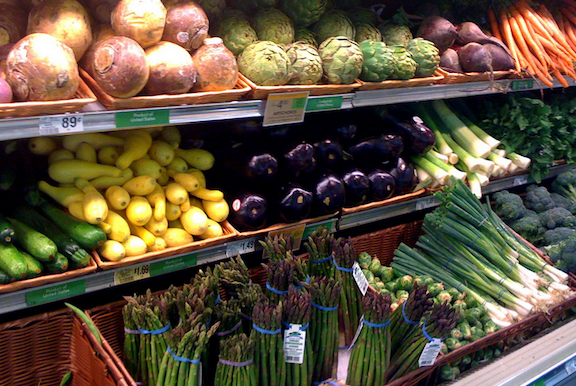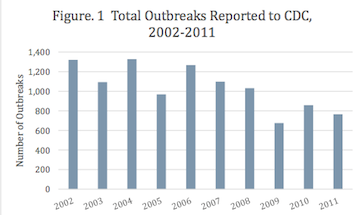Study Finds Produce, Restaurants Most Likely To Give Consumers Foodborne Illnesses
The report “Outbreak Alert! 2014” [PFD] found that 1,610 outbreaks in restaurants sickened more than 28,000, whereas only 893 outbreaks causing 13,000 cases of illness were linked to private homes.
Researchers with the nonprofit safety group analyzed 10,409 solved outbreaks of foodborne illnesses reported to the Centers for Disease Control and Prevention over a 10-year period. A case is considered solved when both a food and a pathogen were identified by investigators.
By examining outbreaks, a cluster of two or more illnesses resulting from the same contaminated food source, researchers were able to provide analysis of foodborne outbreak and illness trends.
The study found oversight from different agencies varied when it came to foodborne illnesses. Fresh produce, seafood, and packaged foods regulated by the Food and Drug Administration were responsible for more than twice as many solved outbreaks as meat and poultry products, which are regulated by the U.S. Department of Agriculture.
However, that statistic could change now that the new FDA Food Safety Modernization Act was signed into law in 2011. The Act gives the agency the authority to conduct more frequent inspections of food processing facilities.
Produce accounted for the largest number of outbreaks, 667, causing 23,748 illnesses. The second most common category linked to outbreaks was seafood. However, of the 602 outbreaks linked to the category only 5,317 illnesses were reported.
Produce, seafood, poultry, and beef were responsible for the largest number of foodborne illnesses during the study. However, over the decade outbreaks and illnesses linked to the four categories decreased significantly.
Instead, reports of outbreaks and illnesses associated with dairy products increased as the decade went on. Researchers say an increase in popularity of unpasteurized dairy products could be to blame.
CSPI found that raw-milk caused 70 percent of the 104 outbreaks linked to milk products. So, although less than 1% of consumers drink raw milk, they bear 70% of the burden of illnesses caused by milk-bourne outbreaks.
“Pasteurization of milk is one of the most important public health advances of the last 100 years, sparing countless people from infections and deaths caused by Salmonella, E. coli, and Listeria,” Sarah Klein, CSPI senior food safety attorney, says in a news release. “Consumers should avoid raw milk, and lawmakers should not expand its availability.”
Additionally, CSPI found a trend of decreased reporting of foodborne illnesses as the study progressed.
States reported 42% fewer outbreaks to the CDC in 2011 than they did when the study began in 2002.
However, researches warn that fewer reported outbreaks doesn’t mean that fewer consumers are getting sick. Instead, they say the recession, influenza pandemics and post-9/11 bioterrorism investments have all diverted state public health budgets and attention away from identifying outbreaks and determining their causes.
“Underreporting of outbreaks has reached epidemic proportions,” Caroline Smith DeWaal, CSPI food safety director, says in a news release. “Yet the details gleaned from outbreak investigations provide essential information so public health officials can shape food safety policy and make science-based recommendations to consumers. Despite the improvements in food safety policy in the past decade, far too many Americans still are getting sick, being hospitalized, or even dying due to contaminated food.”
Want more consumer news? Visit our parent organization, Consumer Reports, for the latest on scams, recalls, and other consumer issues.



